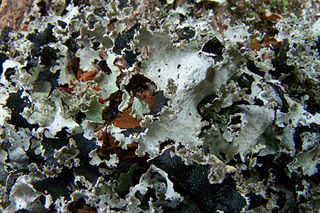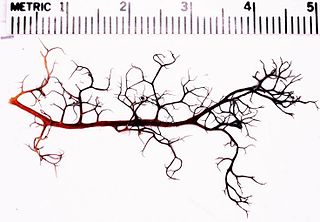
Parmelia is a genus of medium to large foliose (leafy) lichens. It has a global distribution, extending from the Arctic to the Antarctic continent but concentrated in temperate regions. There are about 40 species in Parmelia. In recent decades, the once large genus Parmelia has been divided into a number of smaller genera according to thallus morphology and phylogenetic relatedness.

The Parmeliaceae is a large and diverse family of Lecanoromycetes. With over 2700 species in 71 genera, it is the largest family of lichen-forming fungi. The most speciose genera in the family are the well-known groups: Xanthoparmelia, Usnea, Parmotrema, and Hypotrachyna.
Irwin M. Brodo is an emeritus scientist at the Canadian Museum of Nature, in Ottawa, Ontario, Canada. He is an authority on the identification and biology of lichens. Irwin Brodo was honored in 1994 with an Acharius Medal presented to him by the International Association for Lichenology.

Letharia is a genus of fruticose lichens belonging to the family Parmeliaceae.

Ahtiana is a genus of lichenized fungi known as candlewax lichens in the family Parmeliaceae. A monotypic genus, it contains the single species Ahtiana sphaerosporella or the mountain candlewax lichen, found in western North America. This species was segregated from the genus Parmelia by the Canadian lichenologist Trevor Goward in a 1985 publication. It had been suggested that the genus include A. aurescens and A. pallidula based on similarities in morphology, but this transfer is not supported by molecular analysis.

Kaernefeltia is a genus of lichenized fungi in the family Parmeliaceae.

Hypogymnia is a genus of foliose lichens in the family Parmeliaceae. They are commonly known as tube lichens, bone lichens, or pillow lichens. Most species lack rhizines that are otherwise common in members of the Parmeliaceae, and have swollen lobes that are usually hollow. Other common characteristics are relatively small spores and the presence of physodic acid and related lichen products. The lichens usually grow on the bark and wood of coniferous trees.

Flavoparmelia is a genus of foliose lichens in the family Parmeliaceae. Because of their appearance, they are commonly known as greenshield lichens. The widely distributed genus contains 32 species. It was circumscribed by American lichenologist Mason Hale in 1986 to contain 17 former Pseudoparmelia species with broad lobes, usnic acid in the cortex, and isolichenan in the cell walls.

Canoparmelia is a genus of lichen-forming fungi in the family Parmeliaceae. The widespread genus contains about 35 species. Canoparmelia, a segregate of the parmelioid lichen genus Pseudoparmelia, was circumscribed by John Elix and Mason Hale in 1986.

Bulbothrix is a genus of lichen-forming fungi in the family Parmeliaceae. This genus is synonymous with Bulbothricella V.Marcano, S.Mohali & A.Morales. Bulbothrix was circumscribed by lichenologist Mason E. Hale in 1974 with Bulbothrix semilunata as the type species.

Relicina is a genus of foliose lichens belonging to the large family Parmeliaceae. It contains 59 species.

Platismatia is genus of medium to large foliose lichens in the family Parmeliaceae. The genus is widespread and contains 11 species. They resemble many other genera of foliose lichens in the Parmeliaceae, particularly Parmotrema, Cetrelia, and Asahinea. Most species are found in forests on the trunks and branches of conifer trees, although some species grow on rocks.

Gowardia is a genus of medium-sized, greyish hair lichens in the family Parmeliaceae. It is a circumpolar genus, mainly restricted to arctic-alpine habitats in northern Canada, Europe, and Russia.

Bryoria is a genus of lichenized fungi in the family Parmeliaceae. Many members of this genus are known as horsehair lichens. The genus has a widespread distribution, especially in boreal and cool temperate areas.

Parmelia fraudans is a species of foliose lichen in the family Parmeliaceae. It is found in Europe and North America, where it grows on rocks.
Parmelia imbricaria is a species of foliose lichen in the family Parmeliaceae. Found in western Canada, it was formally described as a new species in 2017 by Trevor Goward, Pradeep Kumar Divakar, María del Carmen Molina, and Ana Crespo. The type specimen was collected by Goward near the Clearwater River drainage, where it was found at an altitude of 700 m (2,300 ft) growing on a basalt boulder. The specific epithet refers to the "imbricate" lobes of the thallus. The lichen occurs in western Canada, with a range including southern Yukon and extending south to southern inland British Columbia. The European Parmelia pinatifida is a closely related species.

Gowardia zebrina is a rare species of fruticose lichen in the family Parmeliaceae. Found in Canada, it was formally described as a new species in 2020 by the lichenologists Trevor Goward and Leena Myllys. The type specimen was collected by Goward on Mount Cain at an altitude of 1,440 m (4,720 ft). Here the lichen was found growing on the lower branches of a hemlock tree. The specific epithet zebrina refers to the diagnostic alternating pale and dark banding pattern of the terminal branches. The lichen has a limited distribution, as it is only known to occur in coastal northwest North America, extending from the Insular Mountains of southern Vancouver Island north to Hazelton. Its preferred habitat is in open, wind-scoured old growth forests, and its preferred substrate is the trunks and lower branches of conifer trees like fir and hemlock.
Parmelia encryptata is a species of corticolous (bark-dwelling), foliose lichen in the family Parmeliaceae. Found in the Iberian Peninsula, it was formally described as a new species in 2011 by Ana Crespo, Pradeep Kumar Divakar, and Maria del Carmen Molina. It is cryptic species that is a member of the Parmelia sulcata species complex, and it is morphologically indistinguishable from that lichen. Molecular phylogenetic analysis, however, shows that it is a genetically unique species originating from a different lineage. Parmelia encryptata has been estimated to have diverged from the P. squarrosa complex about 5.4 million years ago.

Dendriscosticta is a genus of foliose lichens in the family Peltigeraceae. The genus was circumscribed in 2013 by lichenologists Bibiana Moncada and Robert Lücking with Dendriscosticta wrightii assigned as the type species. The genus, a segregate of Sticta, was created to contain species in the Sticta wrightii clade. Dendriscosticta has a sister taxon relationship with the genera Yoshimuriella and Lobariella. Dendriscosticta is distinguished from Sticta by the presence of algae in the excipulum.
Trevor Goward is a Canadian environmentalist and lichenologist known for his contributions to lichenology and his environmental conservation, particularly in British Columbia. Goward has authored numerous publications on lichens, including taxonomic guides, and has conducted observational studies that challenge established scientific understandings of lichen symbiosis. Despite lacking formal training in biology, he has served as the curator of the University of British Columbia's lichen herbarium since 1989 and has had several lichen species named in his honour.
















